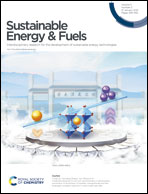Understanding the role of nickel–iron (oxy)hydroxide (NiFeOOH) electrocatalysts on hematite photoanodes†
Abstract
Hematite (α-Fe2O3) modified with a nickel–iron (oxy)hydroxide (NiFeOOH) electrocatalyst is among the most promising photoanodes for photoelectrochemical water splitting. Previous studies have demonstrated that a NiFeOOH overlayer on the α-Fe2O3 photoanode enhances the photoelectrochemical performance; however, the mechanism underlying this improvement remains poorly understood. In this paper, we report on how the NiFeOOH overlayer affects the energetics of the photoanode and the kinetics of surface charge carriers as a function of NiFeOOH thickness. It was found that a thin NiFeOOH film not only reduced surface charge recombination but also increased the water oxidation kinetics. This result is in conflict with earlier studies asserting that surface modification of semiconductor electrodes with oxide-based electrocatalysts does not affect the water oxidation kinetics. The distinctive dual-function character of the NiFeOOH overlayer arises from the combination of the remarkable catalytic activity of NiFeOOH and the properties of photo-assisted electrodeposition. However, thick NiFeOOH films lead to a substantial decrease in photocurrent owing to the low conductivity of the segregated FeOOH phase in the film.



 Please wait while we load your content...
Please wait while we load your content...